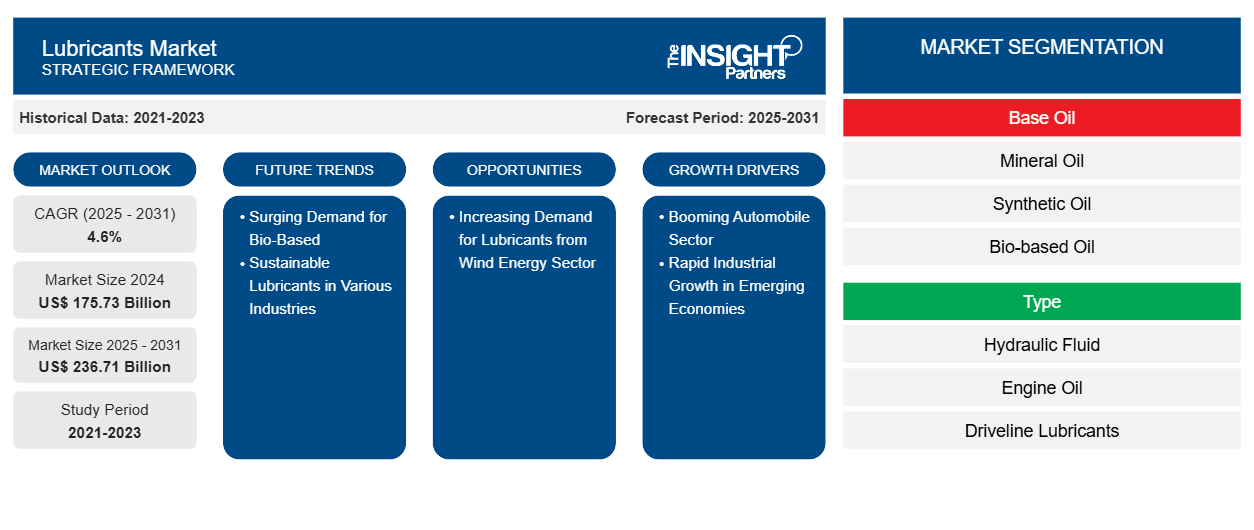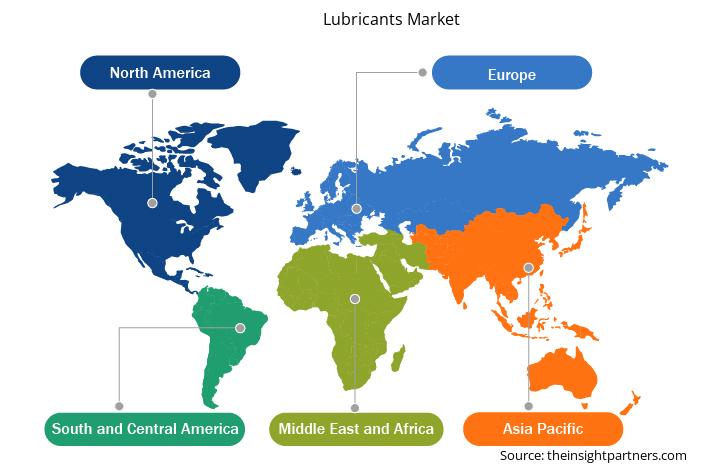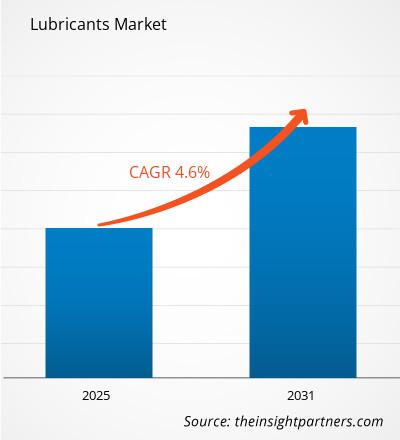윤활제 시장 규모는 2024년 1,757억 3,000만 달러에서 2031년 2,367억 1,000만 달러로 성장할 것으로 예상되며, 2025~2031년 동안 시장은 4.6%의 CAGR을 기록할 것으로 예상됩니다. 다양한 산업에서 바이오 기반 및 지속 가능한 윤활제에 대한 수요가 급증하는 것이 시장의 주요 추세가 될 것으로 예상됩니다.
윤활제 시장 분석
글로벌 제조업체는 개발 도상국의 자동차 판매를 늘리기 위해 공급망을 개선하는 데 투자하고 있습니다.인도 자동차 제조업체 협회(SIAM)에 따르면 인도의 승용차 판매는 2022년 11월의 약 2,409,535대에서 2023년 11월 약 2,854,242대로 증가했습니다.남아프리카 자동차 제조 산업은 생산된 차량 수 면에서 세계 22위이며 아프리카 대륙에서 가장 크며 2023년 대륙에서 조립된 차량의 약 54% 이상을 차지합니다.국제 자동차 제조업체 기구(OICA)에 따르면 브라질은 2023년 남중부 아메리카에서 경형 및 상용차의 가장 큰 제조 및 수출국이었습니다.이 나라는 2022년에 약 230만 대의 차량을 생산했다고 보고했습니다.전통적으로 윤활유는 마찰을 줄이고 마모를 방지하며 엔진 열을 관리하는 데 도움이 되는 내연 기관(ICE) 차량에 필수적이었습니다.그러나 EV의 부상으로 윤활유 시장에 새로운 역동성이 도입 되었습니다 . 전기 자동차는 전통적인 엔진이 없음에도 불구하고 변속기, 모터 및 기타 구동계 부품과 같은 여러 구성품에서 여전히 윤활유에 의존합니다. 따라서 성장하는 자동차 산업은 윤활유에 대한 수요를 가속화하여 더 나은 차량 성능과 수명에 기여하고 있습니다.
윤활제 시장 개요
전 세계 여러 나라가 산업화를 겪고 있으며, 이로 인해 여러 부문에서 기계 및 장비 사용이 급증하고 있습니다. 제조, 건설, 광업, 농업과 같은 산업은 최적의 성능과 수명을 위해 윤활제가 필요한 기계에 크게 의존합니다. 산업 활동이 증가하고 건설 및 농업 산업이 성장함에 따라 윤활제 수요가 증가할 것으로 예상됩니다.
귀하의 요구 사항에 맞게 이 보고서를 사용자 정의하세요
이 보고서의 일부 또는 국가 수준 분석, Excel 데이터 팩을 포함하여 모든 보고서에 대한 사용자 정의를 무료로 받을 수 있으며 신생 기업 및 대학을 위한 훌륭한 혜택과 할인 혜택을 이용할 수 있습니다.
윤활제 시장: 전략적 통찰력

-
이 보고서의 주요 시장 동향을 알아보세요.이 무료 샘플에는 시장 동향부터 추정 및 예측까지 다양한 데이터 분석이 포함됩니다.
윤활유 시장 동인 및 기회
신흥 경제권의 급속한 산업 성장이 시장 성장을 촉진합니다
미네랄 및 합성 윤활제, 그리스, 압축기 오일, 절삭유와 같은 여러 유형의 윤활제는 석유 및 가스, 섬유, 광업 및 야금, 발전, 제지 및 펄프, 화학 및 석유화학, 농업, 제조, 식품 및 음료, 제약 산업에서 사용 됩니다 . 2024년 11월 Trading Economics에서 발표한 데이터에 따르면 중국의 산업 생산은 5.4% 증가했습니다. 광업 부문이 견고한 성장을 경험함에 따라 윤활제에 대한 필요성이 심화되고 있는데, 이는 주로 광업 작업에서 중장비를 광범위하게 사용하기 때문입니다. 광물의 추출 및 가공에 필수적인 이러한 기계는 원활한 작동을 보장하고 마모를 줄이며 작동 수명을 연장하기 위해 효율적인 윤활이 필요합니다. 혹독한 작동 조건이 특징인 광업 활동은 장비 구성 요소에 상당한 스트레스를 줍니다. 윤활제는 마찰을 완화하고, 온도를 관리하고, 부식을 방지하는 데 중요하며, 이를 통해 광업 기계의 전반적인 성능과 수명을 향상시킵니다. 광물과 금속에 대한 수요가 급증함에 따라 광산 작업이 촉진되고, 광산 회사들이 장비의 유지관리와 최적화를 우선시함에 따라 윤활유 시장도 그에 따라 상승세를 보입니다.
풍력 에너지 부문의 윤활유 수요 증가로 시장 성장 기회 창출
풍력 에너지는 가장 빠르게 성장하는 재생 에너지 기술 중 하나로, 전력 산업에서 윤활유를 소비하는 데 잠재적인 점유율을 보유하고 있습니다. WindEurope에서 발표한 데이터에 따르면, 2023년 유럽은 18.3GW의 새로운 풍력 발전 용량을 설치했으며 2024~2030년 동안 260GW의 새로운 풍력 발전 용량을 설치할 것으로 예상됩니다. 이 지역의 여러 국가가 재생 에너지원, 특히 풍력을 받아들이면서 풍력 터빈의 원활한 작동을 보장하는 특수 윤활유에 대한 필요성이 가장 중요해졌습니다. 이러한 윤활유는 풍력 에너지를 활용하는 데 관련된 복잡한 기계의 운영 효율성과 수명을 향상시킵니다. 확장되는 풍력 에너지 부문은 풍력 터빈의 기계적 구성 요소의 마모를 완화하고 마찰을 줄이며 부식을 방지하기 위해 고성능 윤활유를 안정적이고 일관되게 공급해야 합니다. 이러한 수요는 연구 개발의 길을 열어 풍력 에너지 환경이 제기하는 고유한 과제에 맞게 조정된 윤활유 제형의 혁신을 촉진합니다.
윤활유 시장 보고서 세분화 분석
윤활유 시장 분석에 기여한 주요 부문은 기유, 유형, 최종 사용 산업입니다.
- 윤활유 시장은 기유를 기준으로 광물유, 합성유, 바이오기반 오일로 구분됩니다.
- 시장은 유형별로 유압유, 엔진 오일, 구동계 윤활유, 금속 가공유, 그리스, 가공 오일, 냉각수 및 기타로 구분됩니다.
- 최종 사용 산업 측면에서 시장은 자동차, 건설 및 건설, 발전, 광업 및 야금, 식품 가공, 석유 및 가스, 해양, 항공 및 기타로 세분화됩니다. 자동차 부문은 승용차, 경상용차, 중상용차 및 기타로 더 세분화됩니다.
지역별 윤활유 시장 점유율 분석
윤활유 시장 보고서의 지리적 범위는 주로 북미, 아시아 태평양, 유럽, 중동 및 아프리카, 남미 및 중부 아메리카의 5개 지역으로 나뉩니다.
아시아 태평양 지역은 예측 기간 동안 시장을 지배할 것으로 예상됩니다. 아시아 태평양 지역은 이 지역에서 운영되는 국제 및 국내 기업이 많은 자동차 제조의 중심지입니다. 중국 승용차 협회에서 발표한 보고서에 따르면, 테슬라는 2022년에 중국산 전기차 83,135대를 판매하여 2021년에 비해 전기차 판매가 증가했음을 나타냈습니다. 중국 자동차 제조업 협회에 따르면, 2023년에 중국에서 약 6,000대의 연료 전지 전기차가 판매되어 전년 대비 72% 증가했습니다. 인도 브랜드 자산 재단에 따르면, 2023년 인도의 연간 자동차 생산량은 2,590만 대에 달했습니다. 2024년 9월, 승용차, 3륜차, 2륜차, 4륜차의 총 생산량은 2,773,039대였습니다. 윤활제는 엔진, 변속기, 차동 장치와 같은 자동차 구성품에 사용되어 마찰을 줄이고 연료 효율을 높여 차량의 최적 성능과 수명을 보장합니다.
중국, 일본, 한국은 조선 부문에서 선두적인 국가입니다. 조선 그리스는 원소 및 부식성 염수에 대한 저항성, 고압에 대한 저항성, 선박 구성품의 수명 연장과 같은 특성을 부여합니다.
윤활제 시장 지역 통찰력
Insight Partners의 분석가들은 예측 기간 동안 윤활유 시장에 영향을 미치는 지역적 추세와 요인을 철저히 설명했습니다. 이 섹션에서는 북미, 유럽, 아시아 태평양, 중동 및 아프리카, 남미 및 중미의 윤활유 시장 세그먼트와 지리에 대해서도 설명합니다.

- 윤활유 시장에 대한 지역별 특정 데이터 얻기
윤활유 시장 보고서 범위
| 보고서 속성 | 세부 |
|---|---|
| 2024년 시장 규모 | 1,757억 3,000만 달러 |
| 2031년까지 시장 규모 | 2367억 1천만 달러 |
| 글로벌 CAGR (2025-2031) | 4.6% |
| 역사적 데이터 | 2021-2023 |
| 예측 기간 | 2025-2031 |
| 다루는 세그먼트 |
베이스 오일로
|
| 포함된 지역 및 국가 |
북아메리카
|
| 시장 선도 기업 및 주요 회사 프로필 |
|
윤활유 시장 참여자 밀도: 비즈니스 역학에 미치는 영향 이해
윤활제 시장 시장은 소비자 선호도의 변화, 기술 발전, 제품의 이점에 대한 인식 증가와 같은 요인으로 인해 최종 사용자 수요가 증가함에 따라 빠르게 성장하고 있습니다. 수요가 증가함에 따라 기업은 제품을 확장하고, 소비자의 요구를 충족하기 위해 혁신하고, 새로운 트렌드를 활용하여 시장 성장을 더욱 촉진하고 있습니다.
시장 참여자 밀도는 특정 시장이나 산업 내에서 운영되는 회사나 기업의 분포를 말합니다. 주어진 시장 공간에 얼마나 많은 경쟁자(시장 참여자)가 존재하는지 그 규모나 총 시장 가치에 비해 나타냅니다.
윤활유 시장에서 활동하는 주요 회사는 다음과 같습니다.
- 캐스트롤 유한회사
- 쉘 주식회사
- 펜조일
- 퀘이커 스테이트 루브리케이션 리미티드
- 토탈에너지스 SE
- 레프솔 그룹
면책 조항 : 위에 나열된 회사는 어떤 특별한 순서에 따라 순위가 매겨지지 않았습니다.

- 윤활제 시장의 주요 기업 개요를 알아보세요
윤활제 시장 뉴스 및 최근 개발
윤활제 시장은 1차 및 2차 조사에서 정성적, 정량적 데이터를 수집하여 평가하는데, 여기에는 중요한 기업 간행물, 협회 데이터, 데이터베이스가 포함됩니다. 윤활제 시장의 몇 가지 개발 사항은 다음과 같습니다.
- Castrol은 브랜드 인지도와 판매를 촉진하기 위해 영국에서 'First Car Love Stories' 캠페인을 시작했습니다. (Castrol Limited, 회사 웹사이트, 2024년 8월)
- Repsol은 Tekniker와 힘을 합쳐 나노기술을 이용한 윤활유를 개발했습니다. (Repsol, 회사 웹사이트, 2024년 9월)
- Repsol은 60% 재활용 플라스틱 함량을 통합한 새로운 윤활유 포장을 출시했습니다. (Repsol, 회사 웹사이트, 2024년 3월)
- Castrol은 새로운 ACEA Heavy-Duty 사양을 충족하는 새로운 VECTON 완전 합성 상용차 윤활유를 출시했습니다. (Castrol Limited, 회사 웹사이트, 2024년 8월)
- ExxonMobil은 품질 제품 혁신에 초점을 맞춰 Mobil 브랜드 윤활유 및 화학 제품을 확장했습니다. (ExxonMobil, Company News, 2023년 9월)
- Shell Lubricants는 영국에 본사를 둔 MIDEL과 MIVOLT를 인수하여 전력 및 재생 에너지 부문의 제품 포트폴리오를 강화했습니다. (Shell, Company News, 2023년 10월)
윤활유 시장 보고서 범위 및 제공물
"윤활유 시장 규모 및 예측(2021-2031)" 보고서는 아래 영역을 포괄하는 시장에 대한 자세한 분석을 제공합니다.
- 범위에 포함된 모든 주요 시장 부문에 대한 윤활유 시장 규모 및 예측
- 윤활유 시장 동향과 드라이버, 제약 및 주요 기회와 같은 시장 역학
- 포터의 5가지 힘과 SWOT 분석에 대한 자세한 설명
- 주요 시장 동향, 국가 프레임워크, 주요 업체, 규정 및 최근 시장 개발 사항을 다루는 윤활유 시장 분석입니다.
- 시장 집중도, 히트맵 분석, 유명 업체 및 윤활유 시장의 최근 동향을 포괄하는 산업 환경 및 경쟁 분석
- 자세한 회사 프로필
- 과거 분석(2년), 기준 연도, CAGR을 포함한 예측(7년)
- PEST 및 SWOT 분석
- 시장 규모 가치/거래량 - 글로벌, 지역, 국가
- 산업 및 경쟁 환경
- Excel 데이터세트
최근 보고서
관련 보고서
사용 후기
구매 이유
- 정보에 기반한 의사 결정
- 시장 역학 이해
- 경쟁 분석
- 고객 인사이트
- 시장 예측
- 위험 완화
- 전략 기획
- 투자 타당성 분석
- 신흥 시장 파악
- 마케팅 전략 강화
- 운영 효율성 향상
- 규제 동향에 발맞춰 대응






















 무료 샘플 받기 - 윤활유 시장
무료 샘플 받기 - 윤활유 시장